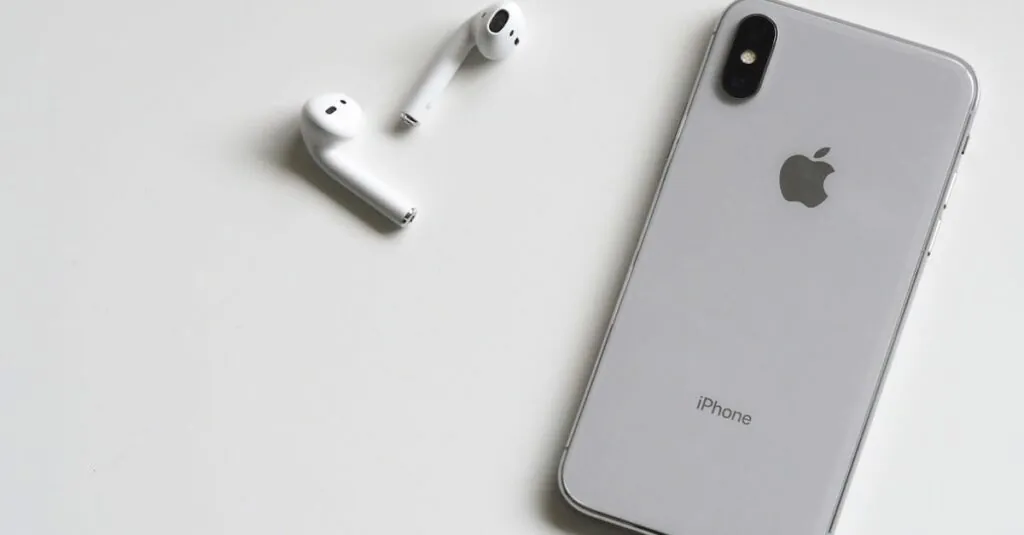Table of Contents
ToggleIn a world where every sound bite can spark joy or ignite a dance party, knowing how to save an audio file on an iPhone is a must-have skill. Whether it’s that catchy tune you can’t get out of your head or an important voice memo, keeping those audio gems handy can make life a whole lot easier. After all, who wants to risk losing their favorite podcast episode or that hilarious voicemail from a friend?
Understanding Audio Files on iPhone
Audio files play a significant role in how users interact with their devices. Familiarity with these files enhances the experience of managing music, recordings, and more.
Common Audio File Formats
Several audio file formats are prevalent on iPhones. MP3 represents a widely used format, known for its balance of quality and file size. WAV provides excellent sound clarity, though it occupies more storage space. AAC, or Advanced Audio Codec, is the default format for iTunes and offers better quality than MP3 at smaller file sizes. M4A also becomes common for music files on the iPhone, providing high-quality audio without large storage demands. Other formats, like AIFF, cater to professionals who require superior audio fidelity.
Importance of Saving Audio Files
Saving audio files increases accessibility to important content. Users can keep favorite songs, essential voice memos, and treasured podcasts at their fingertips. Ensuring audio files remain on the device prevents accidental loss during updates or deletions. Storing files allows for easy sharing with others, whether transferring a song or sending a recording. Organizing these files into folders or playlists not only simplifies locating them but also enhances overall audio management on the iPhone. The convenience of saving audio files promotes a seamless user experience.
Steps to Save an Audio File on iPhone
Saving audio files on an iPhone involves a few simple methods. Users can choose between built-in applications or third-party solutions depending on their needs.
Using Voice Memos App
The Voice Memos app serves as an efficient option for recording and saving audio. Open the app, tap the red record button, and start speaking or playing the desired audio. Once finished, tap the stop button. A list of recorded files appears, and users can rename files by tapping on the title. To save, simply tap Done. Files can be shared through messages, email, or other apps by selecting the audio, tapping the share icon, and choosing the preferred method.
Using Third-Party Apps
Numerous third-party apps offer audio saving capabilities, providing more features and flexibility. Applications like Dropbox, Google Drive, and audio editing apps streamline the process of saving and organizing audio files. After downloading an app, users can record or import audio easily. Follow the on-screen instructions to save or export files to the desired location. Each app typically has a share function that allows easy distribution of saved files via email or messaging platforms.
Alternative Methods
Exploring alternative methods for saving audio files on an iPhone opens up various options that enhance user convenience. Users can quickly access these methods to store their favorite audio content.
Saving from Email or Messages
Audio files sent via email or messages can easily be saved to an iPhone. Users can tap on the audio file within the email or message. Then, selecting the share icon displays a list of options. Choosing “Save to Files” enables users to store the file in a preferred location. This process allows quick access to the audio content later. Saved files can be organized into folders for efficient management. Utilizing this method makes saving audio convenient, regardless of the source.
Using Cloud Storage Services
Cloud storage services facilitate saving audio files directly on an iPhone. Popular options like Dropbox and Google Drive provide seamless integration with iPhone applications. Users can upload audio files from their computer or record directly using the app. Once uploaded, navigating to the file within the app allows users to download or save it to their iPhone storage. Accessing audio files from anywhere becomes achievable with these services. Organizing audio files into specific folders enhances overall management and quick retrieval. This method maximizes storage efficiency and ensures audio content remains accessible.
Troubleshooting Tips
Several common issues may arise when saving audio files on an iPhone. Users often face problems with file formats or compatibility. Sometimes, audio may fail to play due to an unsupported file type. Free space on the device can also hinder saving capabilities. Without adequate storage, users risk losing new recordings or downloaded files.
Solutions exist for fixing these audio saving problems. To resolve format issues, ensure that the audio is in a compatible format such as MP3 or AAC. Checking available storage should be a priority—users can delete unneeded apps or files to free up space. Restarting the iPhone can resolve temporary software glitches, allowing audio files to save correctly. If using a third-party app, checking for updates can often fix bugs or improve functionality, enhancing the audio saving experience.
Saving audio files on an iPhone is a valuable skill that enhances accessibility and organization. By utilizing built-in apps like Voice Memos or exploring third-party solutions such as Dropbox and Google Drive, users can easily manage their audio content. Understanding different audio formats and employing effective storage techniques ensures that cherished recordings remain safe and readily available.
With these methods in hand, users can confidently save their favorite audio files without the fear of losing them. Embracing these practices not only streamlines the audio experience but also promotes better management of personal content. Whether for leisure or important recordings, knowing how to save audio files can significantly improve the iPhone user experience.







